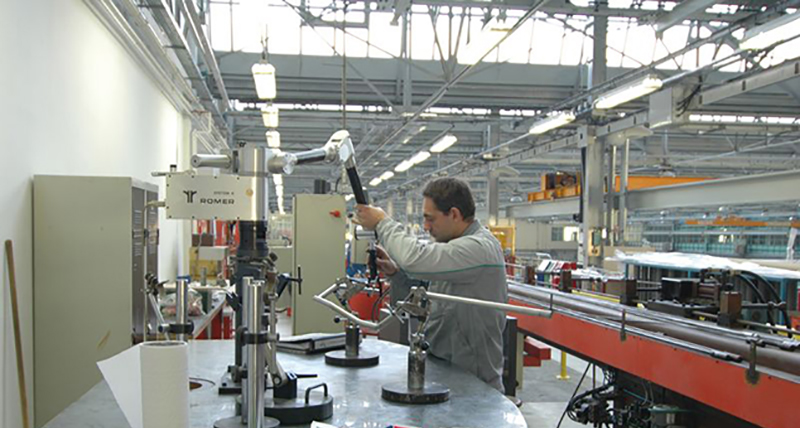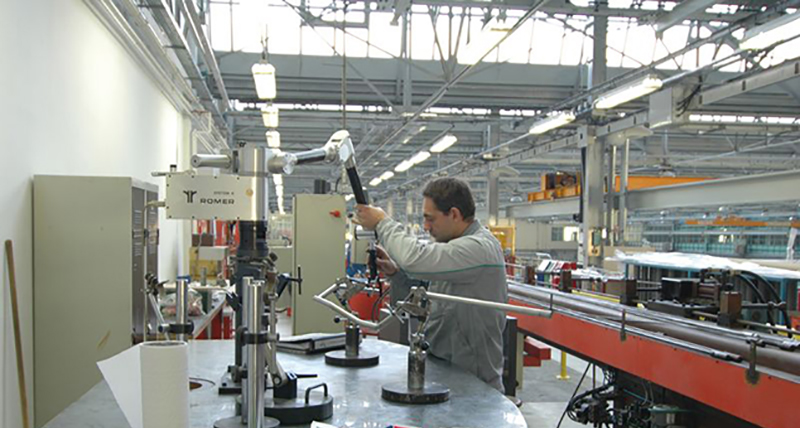Leading aircraft manufacturer loyal articulated arm user for more than 15 years
Dassault Aviation - France
Contact us

A large, financially secure private international group, with a presence in more than 70 countries across 5 continents, Dassault Aviation has been profitable ever since its creation in 1936. Structured to adapt its production to market cycles, Dassault Aviation cooperates with a rich industrial network of high-tech companies in France, Europe, the US and other countries worldwide
"Rafale, Falcon, Mirage 2000, Super Etendard, Alfajet… These names are made of dreams, reflecting the proud French civil and military aviation tradition which came into being after WWII when Marcel Dassault founded his firm. Over the years, the company has earned its righteous place as one of the top-ranking aerospace manufacturers in the world. Dassault boasts the largest number of different aircraft designs of any company in the industry."
Through its engineering design departments, production facilities, the skills of its employees and its product lines, Dassault Aviation offers its customers in-depth know-how, ranging from design to operations, based on strong entrepreneurial values. Dassault Aviation is at the cutting edge of technological innovation and airborne system expertise. The Group aims to provide its customers with innovative and cost-efficient solutions. Through technological development, the concept of the aircraft tends to embody the more realistic idea of complex airborne systems in both civil and military markets.Few companies in the world are now capable of manufacturing these systems that require essential expertise from the design to the production and support stage in terms of coordination, the accounting management of integrated systems and integration. The systems integrator must possess a wide range of skills to take account of all the system‘s technical and financial components, while at the same time knowing how to assess the risks involved in its integration.
 Dassault‘s computer-aided design and manufacturing department, located at the facility at the Bordeaux airport in Merignac, designs and inspects tooling conception, tooling control and retrofitting.
Dassault‘s computer-aided design and manufacturing department, located at the facility at the Bordeaux airport in Merignac, designs and inspects tooling conception, tooling control and retrofitting.This department, under the guidance of Jacky Blasquez, is part of the production department, and is crucially involved in all Dassault‘s projects. Blasquez started as a workshop tool and die maker 32 years ago and has worked his way up as an technical illustrator, consequently heading several departments before assuming the leadership of the design and manufacturing department. “At the beginning, most work was done by hand, later migrating to CADAM and CATIA software for surfacing and tubing drawing. The metrology equipment was rather basic then: theodolites, plummets and rulers. For 3D measurements we had to rely on an external partner. Toward the late eighties our Argenteuil subsidiary had already purchased their first Romer articulated arm, and we used to borrow it from them on a per-need basis. Finally, in 1992 we took delivery of our first
Romer articulated arm. It was incorporated directly into the tube bending process, and has been in daily use ever since – for more than 15 years. The second ROMER articulated arm was delivered to the department in 2004, quickly becoming our most critical measurement instrument.”
Capable, accurate and dependable
The articulated arm is in frequent use at Dassault. The staff is particularly keen on the G-Scan scanner, which can collect thousands of points per second with extremely high accuracies. The same applies to the G-tube software with its accessories for tube measurement. “ROMER covers 100 percent of our metrology needs,” explains Blasquez, continuing: “The service department also deserves high praise because the personnel is knowledgeable and there is always someone to take our call and answer our questions.” Dassault has constructed a custom-made cart for transporting the arm to various physical locations within the premises, including aircraft interiors and exteriors. In addition, the company has constructed its own arm extension which allows them to conduct aircraft interior inspections in one step. Yet another arm elevation system is in the works, which will let them get the elongated arm above the aircraft to reach even more points in one go. To get the measurements of the aircraft underside, the articulated arm has to be mounted upside down, but the quality of the collected data is unaffected.Numerous different measurement tasks
One example of the various challenging tasks at hand is an engine housing enclosure belonging to a Falcon series jet engine, delivered from the Canadian Dassault subsidiary. The part is very shiny in appearance, making it easy to notice any physical imperfections even with the naked eye. A quick scan will quickly let them pinpoint where the imperfections lie so they can implement the necessary modifications in the tooling. Such part inspections occur daily within the department. With the production start of the Rafale and the 7FX version of the Falcon aircraft, new production challenges arose. Dassault has launched a new integrated digitalized network to tackle those two operations. Falcon F7X has established a new standard in terms of product life cycle management standards. The digitized data is frequently exchanged within the production facility, assigning the inspection process with the ROMER arm tremendous importance, both for tooling and part inspection. The finished aircraft needs to comply with the CAD values. Assembly issues are quickly resolved with the articulated arm because the inspection can be done right there on the shop floor, simplifying the correction process. The results are very indicative and leave no room for false interpretation. For example, in the past it was fairly difficult to inspect the correct position of interior paneling alignment. Nowadays, reference points are inspected, a data report is created, and it is immediately clear where the errors lie. This new process allows Dassault to drastically cut inspection times, increasing productivity.
Such part inspections occur daily within the department. With the production start of the Rafale and the 7FX version of the Falcon aircraft, new production challenges arose. Dassault has launched a new integrated digitalized network to tackle those two operations. Falcon F7X has established a new standard in terms of product life cycle management standards. The digitized data is frequently exchanged within the production facility, assigning the inspection process with the ROMER arm tremendous importance, both for tooling and part inspection. The finished aircraft needs to comply with the CAD values. Assembly issues are quickly resolved with the articulated arm because the inspection can be done right there on the shop floor, simplifying the correction process. The results are very indicative and leave no room for false interpretation. For example, in the past it was fairly difficult to inspect the correct position of interior paneling alignment. Nowadays, reference points are inspected, a data report is created, and it is immediately clear where the errors lie. This new process allows Dassault to drastically cut inspection times, increasing productivity.ROMER articulated arms are also essential in all type of tube manufacturing process. The CAD conception and fabrication department under the guidance of Mr. Blasquez digitalizes the tubes and creates their 3D models. With newer tube types, find errors is easy because 3D data exists to facilitate comparison with the tubes coming out of the actual production run. For older tube types, a 3D model first needs to be created by reverse-engineering a reference tube model.
The variety of possible applications for the ROMER articulated arm and the department‘s expertise have allowed Dassault to broaden the arm‘s use well beyond the Merignac location. Mr. Blasquez has recently been to Little Rock, Arkansas facility, where he used the articulated arm to inspect and adjust complex tooling systems that were apparently out of spec. On the same trip, he also visited a military base where he used the arm to reverse-engineer a complex part that was later replicated and installed without the need to polish the part to assure a good fit. All this was done while substantially reducing costs.
Measuring antique parts
The ROMER articulated arm also instills new life into veteran planes. Periodically, the arm is used at the airplane museum for digitizing vintage parts in order to manufacture one-off spare parts that are otherwise no longer available. So don‘t be surprised if you see Mr. Blasquez along with his ROMER arm at a museum near you: a customer may wait impatiently to finally get spare parts for his historic airplane. Often, these reverse-engineered parts are the only way to properly restore an old airplane to its former glory.”With our articulated arm, we always stay within the prescribed tolerances. Reverse engineering is performed with expedience, is effective and accurate,” boasts Mr. Blasquez and concludes: ”Unfortunately, too few people are aware of this tool‘s existence. The utilization of our ROMER arm is sure to increase in the future.”